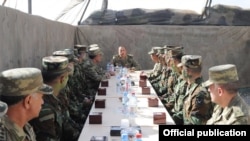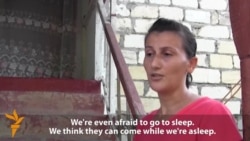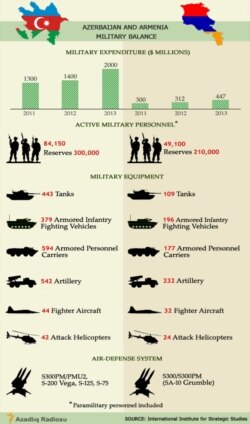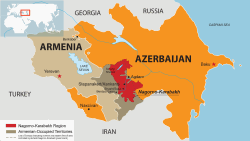The crack of automatic-weapons fire echoes off the sun-burnt hills over the Armenian town of Berkaber.
The normally sleepy, impoverished town nestles against the heavily armed border with neighboring Azerbaijan and was one of many places in the region where sporadic exchanges of fire left at least 15 dead over the weekend of August 1-3.
When RFE/RL Armenian Service correspondent Hovhannes Shoghikian visited the northeastern town on August 2, the correspondents were warned by police not to go farther than the village of Sarigyugh. A local taxi driver told how he'd tried to make it to Berkaber the previous evening.
"Last night at about 10 p.m. I made it to the Nasosny turn when I saw tracer rounds right in front of me," said the man who declined to give his name. "I switched off my lights and my phone, put out my cigarette. I turned around with the lights off and made it back to Sarigyugh."
One man on the road between the two villages said he was helping a neighbor to evacuate his family.
"I'm from Berkaber," he said. "I took my relatives out of the village yesterday. Earlier today I went home because I have some livestock there. Now I'm going back -- my friend is taking his family out of the village."
A little over 100 kilometers to the southeast, the situation is startlingly similar in the Azerbaijani region of Agdam. Locals there came under particularly heavy fire from ethnic Armenians on the night of August 2-3.
"It was as if it was raining bullets," Famil Bagirov, who lives in the village of Orta Garvand, told RFE/RL Azerbaijani Service correspondent Vusale Alibeyli. "We didn't sleep at all. Some men sent their families to safe villages nearby."
Mina Mamishova, a middle-aged neighbor sitting in a noisy yard scattered with scrawny chickens, said the exchanges of gunfire have made it impossible for locals to work their land for fear of snipers.
"We are afraid to go into the houses," she said. "We can't collect the onions out in the fields. We can't go there. We are sitting around like guests. We can't do anything."
The violence shattered a tenuous cease-fire around the Azerbaijani region of Nagorno-Karabakh, a largely ethnic-Armenian region that has been de facto independent since a 1994 cease-fire ended nearly three years of fighting. Tens of thousands were killed, and hundreds of thousands have been displaced now for two decades.
The self-proclaimed republic is heavily dependent on Armenia, and Baku considers the region occupied territory.
The conflict has simmered steadily since the open fighting stopped, and in the ensuing years millions of dollars of sophisticated military equipment have been brought in to the region. If full-scale fighting breaks out in the area again, it will be far more deadly and destructive, analysts say.
Russian President Vladimir Putin has called the Azerbaijani and Armenian presidents to separate meetings with him in the Black Sea resort of Sochi on August 8 and 9, in a bid to shore up the cease-fire.
The Agdam region hugs the Line of Control, which separates the parts of Karabakh controlled by the de facto separatist government from the rest of Azerbaijan, and several towns in the district are controlled by ethnic Armenians. It was the scene of fierce fighting during the 1991-94 war, as Famil Bagirov's bullet-riddled farmyard gate attests.
A local woman who declined to give her name told RFE/RL that she is worried about the latest fighting.
"There was the cease-fire and it was good," she says. "Shooting was rare. They would only shoot at people who went close. But now shootings happen the whole day long. We are afraid, panicking. We are even afraid to sleep. We think that if we sleep, they might come."
On August 6, Azerbaijani President Ilham Aliyev, dressed in military fatigues, visited the Agdam region and seemed in no mood to reduce the tensions. He accused "the Armenian occupying forces" of a "cowardly and villainous" attack on Azerbaijani positions and boasted of his country's sophisticated weaponry.
"Today the Azerbaijani army is capable of destroying any object in Nagorno-Karabakh," Aliyev said. "This is known to us and the people of Azerbaijan. Let this also be known to the enemy."
The same day, Armenian Defense Minister Seiran Ohanian visited the de facto Nagorno-Karabakh capital Stepanakert and discussed security issues with officials there.
Speaking to reporters, Ohanian said "the Armenian forces are competitive in the region and ready to put anyone in their place."
The Armenian border town of Movses also saw exchanges of gunfire in recent days. No one was reported injured there, but several buildings were damaged.
From the village's central street, you can see Azerbaijani military positions in the brown hills above.
"Standing here is dangerous," one woman passing by tells RFE/RL's correspondent. "You can get hit by a sniper at any moment."

















